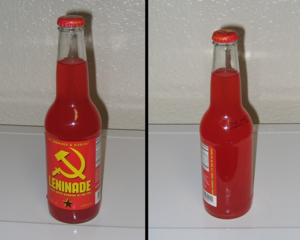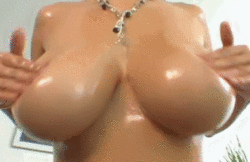Leninade
 | |
 Photos from the multi-billion dollar advertising campaign | |
| Type | Soda |
|---|---|
| Manufacturer | CCCP |
| Country of origin | Soviet Union |
| Color | Red with the blood of the Bourgeoisie |
| Flavour | None |
| Ingredients | Carbonated Acid, Sugar, Water, White spirit, Cesium-137, Graphite |
| Website | leninade.ru |
“On a hot day, refresh yourself with a cold war!”
– Leninade
“When God gives you Lenins, make Leninade.”
“This is Radio Armenia. Our listeners asked us: 'Is Leninade really the leader's blood?' We responded, 'No, but 777 Port is the leader's urine.'”
– a Russian joke
Leninade is a soft drink of Russian origin that, since its inception, has appeased the thirst of the proletariats. Leninade is innovative in that the means to produce it is not owned by greedy corporate giants, like Pepsi or Coca Cola; as said means of productions have been seized in order to provide to the masses a refreshing beverage like no other. It is distinguisable thanks to its fully-red tainted liquid and by the strange fact that it can never tilt to the right, only to the left. As the label of the bottle says, It’s Сурприсинглъ Сатисфъинг Сожиет Рефрешмент!.
History
 World's gayest cocktail | |
| White Russian | |
|---|---|
| Served | On the rocks (lisped) |
| Ingredients | |
| Preparation | Pour coffee liqueur and vodka into a glass filled with ice. Float fresh cream on top and stir slowly. Make sure you get some on your lips when you take your first camp sip. |
Leninade was first developed by Vladimir Ilyich Ulyanov, better known as Lenin, during the civil war which broke out after the Russian Revolution. The drink was mixed up in vats requisitioned from the Tsar's kitchens, and usually consisted of an alcoholic element mixed with a caffeine-based element, although the exact components and measures depended on what was available (usually vodka and occasionally caffeine tablets). It was said to be a major factor in the Red victory in the civil war as they vanquished the Whites, who were literally fuelled by White Russians, perhaps the most limp-wristed cocktail of all time.
When Lenin died prematurely in 1924, Joseph Stalin was quick to seize on the drink's image as a way to galvanise support for his regime. At Lenin's funeral (from which Leon Trotsky was conspicuously absent), Stalin could clearly be seen sipping sadly from a can of Leninade, with the logo conscientiously positioned to face the cameras, leading some to comment on his hypocrisy.
Later, much to the consternation of former allies of Lenin, Stalin created something of a cult of the former leader, having his body displayed in state in the Hall of Columns, can of Leninade in his dead hand, and with an enormous vat of Leninade which the faithful could drink from, after they had pronounced the words "the blood of Lenin".
“In America, you politicians drink the blood of the people ...”
– beginning of the inevitable Russian Reversal
Scarcity
During the 1920s and 30s, when the Soviet Union endured much hardship due to Stalin's five-year plans, cans of Leninade became a rare sight, as the basic ingredients (whatever they were) became increasingly scarce. Despite this, newspaper reports and news reels would suggest the drink was enjoyed in abundance. Writer George Orwell – who, despite having socialist leanings, had grown critical of the Soviet Regime – wrote of the situation:
Recent history
Khrushchev and his successors made small steps to distance themselves from Stalin's regime, and this included having no public connection with Leninade, although production continued. In the 1980s the drink reached its nadir in popularity, when Mikhail Gorbachev called for glasnost, a political process which called for greater "transparency" in public life, something which clashed badly with Leninade, which was never particularly transparent, and worst of all, was exactly the colour of communism. Then in 1991 Boris Yeltsin, the newly elected President of Russia, accidentally drank some Leninade and remarked to an official, "That vodka has no vodka in it."
In recent years, however, Leninade has made something of a comeback. It was one of the soft drinks available on tap when Russia's first McDonald's opened in 1993; and in early 2015, with the opening of the failed 80s Cafe, Leninade was also available – until the responsible business realised that it was hardly a symbol of that time period. This process intensified with the election of Vladimir Putin. There has been an increasing romanticisation of Leninade on the government’s part, which began with vintage-style postcards and has culminated in Leninade being the mixer of choice in Moscow’s premier vodka bars.
Nora Volkow, Trotsky’s granddaughter, wrote recently: "Whatever Leninade once was, it is now an unintentional symbol of what Russia has become – no more revolutionary or Socialist in nature than a Fanta, or, dare I say it, a Mountain Dew." Volkow's comment crystallised a view held among the older generation of Leninade drinkers: that their beloved beverage, originally a beacon of communist beliefs, has been Americanised.
Hardline traditional socialists of all ages say that Leninade has become commercialised and watered-down "like everything else" and often dub it, mockingly, Capitalade.
The Cambridge Five: British secret Leninade drinkers
During the 1940s and 1950s, five senior members of MI6 – Kim Philby, Donald Duart Maclean, Guy Burgess, Anthony Blunt and Pete Best – secretly drank Leninade in exchange for classified information.
The double agents, later dubbed the Cambridge Five due to their shared university background, handed over so much high-level information in exchange for Leninade that the Russians suspected them of being double-double agents.
agents.
The five continued to get hammered and sickled for several years, until Philby learned Maclean was about to be identified. He sent Burgess to tell MacLean to leave the country, and Burgess obviously thought it was a good idea, because he left as well. When their flats were raided, the authorities found communist propaganda, an eye-popping Russian series of pornographic films called Rusian Dolls: One Inside Other, and several extremely impressive Leninade bottle-pyramids.
Philby was heavily suspected of leaking the information and was dismissed, but escaped prosecution when he chugged a full pint of warm beer, which was then the traditional test of an agent's loyalty.
Incredibly, Philby was later employed again by MI6 in the Middle East, and provided more state secrets to the Russians in exchange for his favourite tipple, which he would lick off the back of Arab male prostitutes.
An old colleague finally exacted a spoken confession from Philby (most of which was burped due to the carbonated nature of the beverage) but when the authorities came back to arrest him the next day, Philby had already fled to Russia on a Leninade-sponsored banana boat.
The scandal was dramatised by author John Le Carre, and was turned into the 1973 feature film Secret Lemonade Drinker.
In other countries
Leninade has enjoyed cult popularity in the United States and some other countries as a slightly sneering symbol of "traditional Soviet values". It is sold alongside "Soviet" postcards and posters of varying authenticity, as a quaint relic of a curious society in which people waited patiently in line, and 1% of the people didn't own 35% of the wealth.
Leninade is illegal in Ukraine. Before the annexation of Crimea in 2014, Russians took to parachuting crates of Leninade across the border, although whether they wanted to win the Ukrainians over with the drink, or make them feel vaguely sick after trying it, has never been established. Putin denied having authorised the move, and claimed that Leninade had always been "readily available" in the Crimea, adding: "Crimea has always been part of Russia. There has always been Leninade in Russia. Therefore there has always been Leninade in the Crimea. Anyone who says differently is a Ukrainian fascist funded by the EU/USA bloc. Move along, nothing to see here."
In China, Leninade is referred to as 红饮料, and was sold for a time thanks to Russia's efforts to get it on their market. However, unknown to the Russian government, there was a run of eighty-nine bottles that were intentionally contaminated with Russian house dust. Chinese consumers avoided all Leninade, and they were forced to withdraw the product. Also, the irony of there being eighty-nine bottles escaped few.
Stalinade
Stalinade was never very popular, due to the unattractive look of the drink, which Trotsky famously described as a "grey blur". Furthermore, there were a number of damaging stories about moustache hairs being found in cans, meaning that only the most loyal of Stalinist lackeys would force themselves to drink it.
Production was quietly discontinued in the late 1920s, and leftover stock was transported to give the prisoners in the Gulags something unpleasant to drink, and perhaps even caffeine poisoning.
Putinade
Putinade was created in 2013 in Putin's latest attempt to juxtapose himself with his famous predecessors. The drink was launched amid much fanfare, with the President's bare-chested, horse-riding image blazoned upon the bottle. Like its predecessor, it sank like a stone; not because of any moustache hairs (indeed, Putin is not someone particularly associated with hairs of any kind) but because the drink's recipe was revealed to be basically expired Sprite Zero with red food colouring.
The drink did, however, come to international attention in 2017, when Oliver Stone was seen sipping from a bottle of Putinade throughout production of his film The Putin Interviews. It is not known how Stone got his hands on the drink, but he is clearly sucking every last drop out of a bottle before licking the rim as Putin insists he had nothing to do with Donald Trump's presidential campaign.
Trotsci
A low-grade cola-based beverage, Trotsci, was created in the 1980s not by government officials but by opposition rebels in an attempt to revive flagging communist spirits. It plagiarised the increasingly popular Pepsi ad campaigns, which had seen the drink overtake Coca Cola in many international markets.
Made to "protect the USSR from the blight of commercialisation" in the words of one creator, the drink was not very popular, primarily due to the visible hypocrisy: a large-scale advertising campaign was rolled out and it was sold in most Russian stores at a massive one-ruble profit.
Furthermore, the drink's logo, which styled Trotsky's hair, moustache and beard in Pepsi's distinctively American red, white and blue colours, was seen as disrespectful and unpatriotic by some. Ironically, Coca Cola was enjoying huge success since the USSR had permitted its sale in 1985 – partly because it symbolised sweet, sweet America, but partly also because of its familiar Mother-Russia red colour-scheme.
Thus, younger Soviets guzzled Coke while dreaming of blonde women with loose sexual values, rock and roll, and Spiderman comics, while their grandparents supped it through the huge gaps in their teeth and thought nostalgically of Alexey Stakhanov, a coal-miner who once mined fourteen times his quota of coal in just five hours, or Alexander Zass, a strongman who was said to have the combined strength of three oxen and a duck.
The final straw for Trotsci, perhaps a poor choice of expression given that Trotsci could not be drunk with a straw due to the large amount of lumps found in the drink, was a poorly-thought-out giveaway.
Because of the slightly grainy texture of Trotsci and its bitter aftertaste, its makers recommended customers drink it with lots and lots and lots of ice. As ice cubes were a luxury in Soviet Russia, most locals would scoop ice from the streets or headbutt icicles hanging from their doorways.
This inspired Trotsci's promotion team to launch a competition which meant Trotsci-lovers could win a special Trotsci icepick if they handed in 1000 ringpulls. Given that Leo Trotsky was murdered in Mexico after taking an icepick to the face, the giveaway led to a huge public backlash, and even Gorbachev spoke of its "bad taste", which, ironically, was a common phrase used to describe Trotsci itself.
A film was later created about it, entitled Breaking the Ice... Or At Least Trying To. The American sound collage group Negativland also discussed Trotsci's advertising campaign, which had associated it with various "bad things", such as tractors taking over large areas of forest, and alcoholic husbands (who were, not surprisingly, advised to drink Leninade instead).





